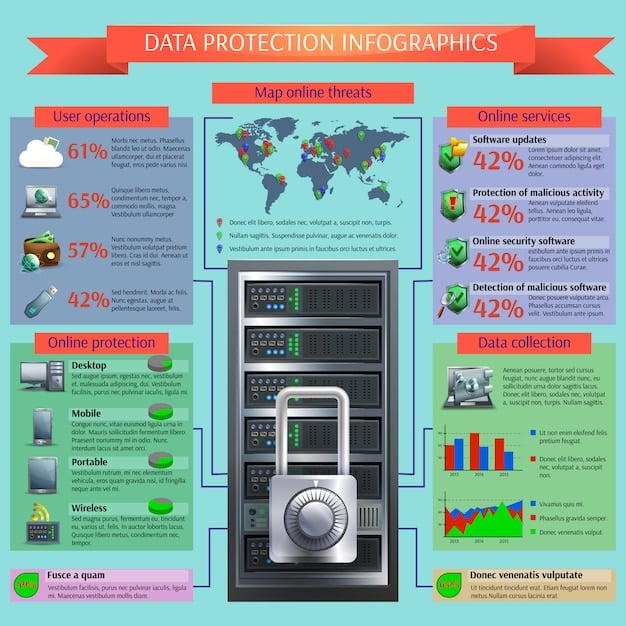US Data Privacy: Key Regulatory Changes in the Next 6 Months

Navigating the evolving landscape of US data privacy, significant regulatory changes are anticipated in the next six months, driven by new state legislation, federal initiatives, and global compliance trends impacting businesses and consumer rights across various sectors.
In an increasingly digital world, understanding what are the key regulatory changes affecting US data privacy in the next 6 months is not just crucial, it’s a strategic imperative. As technology evolves and data collection expands, the legal frameworks governing personal information are in constant flux, creating both challenges and opportunities for businesses operating across the United States.
The Evolving Landscape of US Data Privacy
The United States’ approach to data privacy has historically been sector-specific, contrasting with the more comprehensive, omnibus laws seen in the European Union. However, this trend is rapidly shifting. Over the past few years, we’ve witnessed a proliferation of state-level privacy laws, pushing toward a more unified, if still fragmented, national standard.
This dynamic environment means that businesses, particularly those operating across state lines or handling significant volumes of consumer data, must maintain an agile and proactive stance in their compliance efforts. The next six months are poised to bring further significant developments, driven by ongoing legislative efforts and the enforcement of recently enacted statutes.
The Shift Towards Comprehensive State Privacy Laws
The California Consumer Privacy Act (CCPA), significantly strengthened by the California Privacy Rights Act (CPRA), set a groundbreaking precedent for consumer data rights in the US. Its influence has been undeniable, inspiring similar legislative efforts across numerous states. These laws typically grant consumers specific rights regarding their personal information, including the right to know what data is collected, the right to delete it, and the right to opt-out of its sale.
- Transparency requirements for data collection and usage practices.
- Empowerment of consumers to access and control their data.
- Establishment of dedicated agencies or enforcement mechanisms.
- Provisions for data security and breach notification.
Beyond California, states like Virginia (Virginia Consumer Data Protection Act, VCDPA) and Colorado (Colorado Privacy Act, CPA) were early adopters, introducing similar frameworks. Their success in implementation, along with the challenges faced by businesses in complying, has provided valuable lessons for other states currently drafting or considering their own privacy legislation.
The patchwork nature of these laws presents a complex compliance challenge. Businesses must not only understand the specific nuances of each state’s regulations but also anticipate how these varying requirements can be harmonized into a coherent, nationwide data privacy strategy.
Anticipated State-Level Regulatory Accelerations
As we look at the next six months, a significant portion of the regulatory changes in US data privacy will likely stem from the continued maturation and enforcement of existing state laws, alongside potential new legislative enactments. This period will be crucial for businesses to fine-tune their compliance programs.
Several states have recently passed comprehensive privacy laws that are either nearing their effective dates or entering their initial phases of enforcement. Understanding these specific timelines is critical for businesses to prepare adequately.
Upcoming Enforcement and Effective Dates
For instance, states such as Utah (Utah Consumer Privacy Act, UCPA) and Connecticut (Connecticut Data Privacy Act, CTDPA) have seen their privacy laws come into effect recently, and the focus will now shift to their enforcement. Businesses that have not yet fully aligned with these regulations face a heightened risk of penalties and legal action.
- Utah Consumer Privacy Act (UCPA): While effective, the initial period involves understanding implementation nuances.
- Connecticut Data Privacy Act (CTDPA): Businesses need to ensure their compliance programs are fully operational.
- Other States: Keep an eye on New York, Massachusetts, and Washington, all of which have active legislative discussions.
The enforcement bodies in these states will increasingly look beyond superficial compliance to genuine adherence to privacy principles, scrutinizing data handling practices, consent mechanisms, and data subject request fulfillment. This requires not just policy updates but robust operational changes within organizations.
Furthermore, several other states are still actively debating or preparing to roll out their own versions of comprehensive data privacy laws. While predicting exact timelines is challenging, the momentum suggests that more states will finalize and enact their legislation, adding to the complexity of the US privacy landscape. Businesses with a national footprint must closely monitor legislative trackers and engage with industry groups to stay ahead of these developments.
Federal Initiatives and Their Potential Impact
While state-level activities currently dominate the US data privacy discourse, the prospect of a comprehensive federal privacy law remains a significant, albeit often debated, possibility. The absence of a national standard creates a complex compliance environment for businesses, making the prospect of federal preemption appealing to many.
In the past, various federal proposals, such as the American Data Privacy and Protection Act (ADPPA), have been introduced, aiming to unify the patchwork of state laws. While none have yet succeeded in becoming law, the discussions continue to evolve, reflecting bipartisan concerns over consumer data protection and the need for a more consistent regulatory framework.
The Ongoing Debate for a Federal Privacy Law
A federal privacy law could significantly alter the compliance paradigm in the US. Depending on its scope and preemption clauses, it could either supersede existing state laws, creating a single national standard, or coexist with them, albeit with a minimum baseline of protection. This latter scenario might lead to an even more intricate regulatory landscape if federal and state requirements diverge substantially.
Key areas of focus for any potential federal law include a uniform definition of personal information, standardized consumer rights, clear guidelines for data collection and use by businesses, and a consistent enforcement mechanism. The ongoing debate typically revolves around the extent of preemption, the enforcement powers granted to federal agencies (like the Federal Trade Commission, FTC), and the inclusion or exclusion of a private right of action for consumers.

Over the next six months, while the passage of a comprehensive federal law might still be a long shot given the current political climate, discussions surrounding such legislation will undoubtedly continue. Businesses should monitor these debates closely, as even the direction of legislative intent can provide valuable insights into future compliance requirements.
Furthermore, federal agencies like the FTC and the National Institute of Standards and Technology (NIST) continue to issue guidance and enforce existing sector-specific privacy laws, such as the Children’s Online Privacy Protection Act (COPPA) and the Gramm-Leach-Bliley Act (GLBA). Their interpretations and enforcement actions often provide de facto national standards that businesses should adhere to, regardless of a comprehensive federal law.
Sector-Specific and Emerging Regulatory Concerns
Beyond comprehensive privacy laws, the next six months will likely see increased scrutiny and potential regulatory adjustments within specific sectors, as well as new challenges arising from emerging technologies. These targeted regulations often address unique data handling practices or particularly sensitive types of information.
Healthcare and financial services, for example, have long been subject to stringent data privacy rules through HIPAA and GLBA, respectively. However, the interpretation and enforcement of these laws continue to evolve, especially in response to new data processing methods and the increasing digitization of these industries. The Department of Health and Human Services (HHS) and the Consumer Financial Protection Bureau (CFPB) are continuously updating their guidance and initiating enforcement actions that set new precedents.
Focus on Health Data and Biometrics
One area of heightened focus is health data beyond HIPAA’s traditional scope. With the proliferation of fitness trackers, health apps, and wearable devices, a vast amount of health-related information is being collected outside the purview of HIPAA. States are beginning to address this gap, with some introducing laws specifically targeting consumer health data collected by non-HIPAA covered entities. The implications for companies in the wellness tech space could be significant.
- Regulation of health data collected by consumer devices and apps.
- Increased scrutiny on data sharing practices in the wellness sector.
- Potential for new state-specific health privacy acts.
Similarly, the use of biometric data (fingerprints, facial scans, voiceprints) is another rapidly evolving area. States like Illinois (Biometric Information Privacy Act, BIPA) have strict requirements for obtaining consent before collecting such data, and other states are considering similar legislation. As biometric verification becomes more commonplace, both in consumer devices and workplace settings, the regulatory landscape is adapting to protect this unique and sensitive form of personal information.
Looking ahead, emerging technologies such as artificial intelligence (AI), virtual reality (VR), and the Internet of Things (IoT) will continue to present new privacy challenges. Regulators are still grappling with how existing laws apply to these innovations, and new guidelines or amendments are highly probable. For instance, the use of AI in facial recognition or predictive analytics raises significant concerns about bias, surveillance, and automated decision-making, prompting calls for specific AI governance frameworks that include robust privacy safeguards.
Practical Implications for Businesses
Given the anticipated regulatory changes, businesses operating in the US face a complex but navigable path toward compliance. Proactive measures and a robust data governance strategy are no longer optional but essential for mitigating risks and maintaining consumer trust.
First and foremost, businesses must conduct thorough data mapping exercises. Understanding what personal data they collect, where it comes from, how it’s used, stored, and shared, and with whom, is the foundational step. This inventory will reveal potential compliance gaps across various state laws and illuminate areas of high risk.
Key Steps for Compliance and Risk Mitigation
Implementing strong data security measures is paramount. Even the most comprehensive privacy policies are ineffective if data is vulnerable to breaches. This includes adopting encryption, multi-factor authentication, regular security audits, and employee training on data handling best practices. A data breach can lead to substantial fines, reputational damage, and loss of customer trust, making prevention a top priority.
- Regular Data Audits: Continually assess what data is collected and how it’s processed.
- Consent Management: Implement clear, auditable consent mechanisms, particularly for sensitive data.
- Data Subject Request Fulfillment: Establish efficient processes for handling requests to access, delete, or correct data.
- Vendor Due Diligence: Ensure third-party vendors and partners also comply with privacy standards.

Beyond technical safeguards, businesses need to adapt their organizational policies and procedures. This includes revising privacy notices to be more transparent and easily understandable, updating internal data retention schedules, and establishing clear protocols for responding to data subject access requests (DSARs). Training employees on privacy best practices is also critical, as human error remains a significant source of data breaches.
Finally, businesses should actively engage with legal counsel specializing in data privacy. The nuance of these laws and their varied enforcement across states requires expert guidance. Staying informed through legal updates, industry webinars, and privacy conferences will help businesses adapt their strategies in real-time to the ever-changing regulatory landscape.
Predictions and Outlook for the Next Six Months
As we anticipate the trajectory of US data privacy regulations over the next six months, several key trends and outcomes begin to emerge. While precise predictions are challenging in such a dynamic field, a careful analysis of legislative momentum, technological advancements, and enforcement patterns can provide a strategic outlook.
One clear prediction is the continued divergence in state-level privacy laws, at least for the immediate future. Despite the desire for a federal standard, the legislative calendar and political realities suggest that more states will likely enact their own data privacy statutes before a comprehensive federal law materializes. This will intensify the “patchwork” problem for businesses, necessitating highly adaptable compliance frameworks.
Continued Evolution and Adaptation
We can expect an increase in enforcement actions by state attorneys general and newly established privacy agencies. As laws mature and businesses become more familiar with their obligations, regulators will likely shift from education-focused outreach to more active investigations and imposition of penalties for non-compliance. This will serve as a strong incentive for businesses to prioritize and invest in robust privacy programs.
- Increased enforcement activities at the state level.
- Greater legislative focus on specific data types (e.g., health, biometric).
- Ongoing technological challenges from AI and IoT.
Technologically, the rapid development of AI will continue to be a significant driver of regulatory discussions. The ethical implications and privacy risks associated with AI, particularly in areas like automated decision-making and data inference, will prompt calls for new guidelines or even dedicated legislation. While immediate comprehensive AI regulation might not occur within six months, preliminary frameworks or industry best practices linked to privacy will likely gain traction.
In conclusion, the next six months promise a period of accelerated evolution in US data privacy. Businesses must remain vigilant, adopting agile compliance strategies that can adapt to both new legislative enactments and the stricter enforcement of existing laws. The focus will be on granular understanding of data flows, robust security measures, and transparent communication with consumers. While challenging, navigating this landscape effectively will distinguish responsible and compliant organizations in the marketplace.
| Key Point | Brief Description |
|---|---|
| 🧩 State Legislative Growth | New comprehensive state privacy laws are emerging and existing ones are entering enforcement phases, creating a complex compliance map. |
| 🏛️ Federal Law Prospects | While not guaranteed, discussions for a comprehensive federal privacy law continue to influence the overall regulatory environment. |
| 🧬 Sector-Specific Scrutiny | Increased focus on health data outside HIPAA and biometric information, potentially leading to new targeted regulations. |
| 💡 Technological Challenges | Emerging tech like AI and IoT pose new privacy risks, prompting regulators to adapt existing laws or consider novel frameworks. |
Frequently Asked Questions About US Data Privacy Changes
▼
The primary driver is the proliferation of state-level comprehensive data privacy laws, largely influenced by the California Consumer Privacy Act (CCPA). These state laws are creating a complex, fragmented regulatory landscape, pushing businesses to adapt to varying compliance requirements across different jurisdictions within the US.
▼
While discussions and proposals for a comprehensive federal data privacy law continue, its immediate enactment within the next six months remains uncertain. Political realities and differing opinions on scope and preemption clauses make its passage a long-term goal rather than an imminent reality, although federal agency guidance continues.
▼
Businesses should closely monitor states with recently effective laws like Utah and Connecticut for enforcement trends. Additionally, states such as New York, Massachusetts, and Washington are actively debating or introducing comprehensive privacy legislation, making them critical to watch for potential new enactments or significant amendments.
▼
Emerging technologies like AI introduce new data privacy challenges, particularly concerning automated decision-making, data inference, and bias. Regulators are actively exploring how existing laws apply to these innovations, and new guidelines or specific AI governance frameworks with robust privacy safeguards are likely to emerge in the near future.
▼
Businesses should conduct thorough data mapping to understand their data flows, implement robust data security measures, and update privacy policies to ensure transparency. Establishing efficient processes for data subject requests and providing ongoing employee training on privacy best practices are also critical for mitigating compliance risks and fostering trust.
Conclusion
The landscape of US data privacy is undeniably dynamic, with significant shifts anticipated in the next six months. The ongoing emergence and enforcement of comprehensive state-level privacy laws, coupled with persistent federal discussions and sector-specific scrutiny, underscore a critical need for vigilance among businesses. Adapting to this evolving environment demands proactive data governance, robust security measures, and transparent consumer communication. Organizations that prioritize these aspects will be best positioned to navigate the complexities, build consumer trust, and ensure compliance in a consistently changing regulatory climate.





